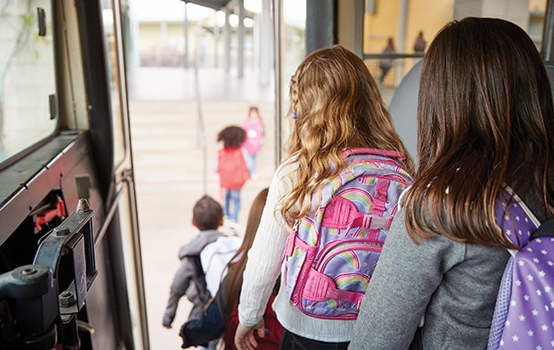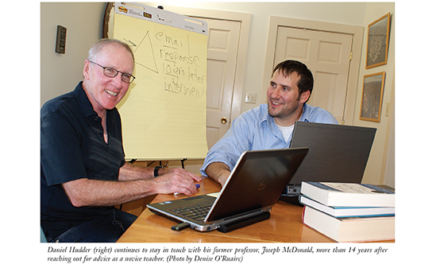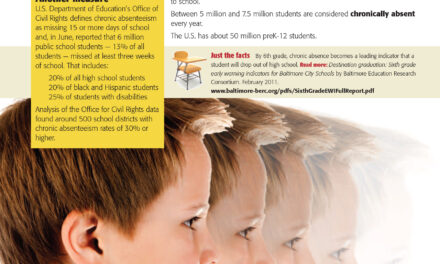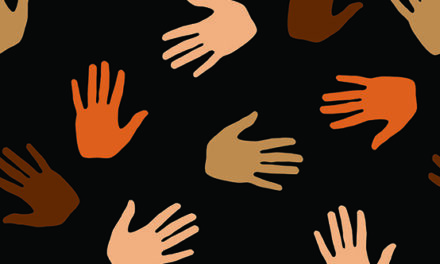Children develop ideas about race at a young age, whether adults talk to them about it or not.
Well-intentioned parents and teachers often say that not talking about race with children will help to reduce racism. Such adults believe that kids are too young to handle information about racism or too innocent to engage with controversial or disturbing topics in the news. Talking about race, this argument goes, only reinforces racism; by avoiding race and racism entirely, kids will come to see everyone as equal.
The problem with this argument is that social science research has shown us for decades that young children notice racial differences at very young ages and learn societal rules about race throughout childhood. Research also shows that although White parents often avoid talking about race with children, parents raising kids of color tend to employ a range of different strategies to help their children navigate a racist social structure — and that kids benefit from such conversations (Hughes et al., 2006). My own research suggests that kids are talking about race, racism, and controversial current events with each other, whether their parents and teachers know it or not. Adults and educators must therefore provide young people with not only the necessary tools to help them understand race and racism but also the opportunity to be heard.
Social science research on race
In the early 1940s, Black psychologists Mamie and Kenneth Clark conducted a series of studies with young Black children to understand how racism affects kids’ understandings of themselves and others. The Clarks’ research, in which children expressed preferences for White dolls over Black dolls, raised questions about children’s racial learning processes and how young people develop their racial beliefs.
Child development scholars have continued to explore what children understand about race and at what age these racial understandings develop. Recent studies have found that children as young as three months old can racially categorize people (Kelly et al., 2005) and that by three years of age, children can express explicit forms of racial bias (Aboud, 2008). By age five, children of color are conscious of existing racist stereotypes about their group and are negatively affected by them (Hirschfeld, 2008). By age eight, White kids learn that it is socially unacceptable to express explicit forms of racial bias — and instead exhibit an increase in implicit forms of prejudice (Raabe & Beelmann, 2011). These are only some examples of the important research in this area.
Child development scholars are not the only researchers who have examined young people’s racial attitudes. Family scholars have explored how young people learn about race in the context of their families (Winkler, 2012), and education scholars have observed kids learning about race in schools (Hooven et al. 2018; Lewis, 2003). Media scholars have explored how influential media is in the lives of young people and have discovered that kids’ media is filled with messages about race (Dubrofsky, 2013). Political scientists and sociologists alike have used racial attitudinal surveys to get a broad sense of how people make sense of the racial landscape (Cohen et al., 2017; Forman & Lewis, 2015). All of these studies have shown that young people learn about race and racism, whether or not their parents have explicit conversations about it.
Kids’ perspectives
My own research on racial socialization pays particular attention to children’s voices. For the past eight years, I have listened to young people share their perspectives on racism and current events in America. This work began with a two-year ethnographic study in 2011-13 with 36 White affluent kids living in the Midwest. And in 2015, I reinterviewed a group of these kids as high school students so that I could explore whether their views changed as they entered adolescence. (I describe how these kids developed their beliefs about race, and the role their social environment played in this process, in my book, White Kids: Growing Up with Privilege in a Racially Divided America; NYU Press, 2018.)
Starting in 2016, I expanded my research to include interviews, conducted in Mississippi and Massachusetts, with kids from varying economic backgrounds who identify as Black, Latinx, White, or biracial (or who identify according to their ethnicity, such as Cape Verdean), about racism in the Trump era. In this study, which continues today, kids have shared their views on a wide range of topics, including immigration, the NFL protests, the Mississippi state flag, the White nationalist racial violence in Charlottesville, educational inequality, and police shootings of Black youth.
Among White kids, differing views
When I began my research in 2011-13, I quickly discovered that not all White kids have the same ideas about race. For instance, many of the children told me that racism is no longer a problem in the United States. As 11-year-old Natalie explained,
Racism is not a problem anymore . . . Racism was a problem when all those slaves were around and that like bus thing and the water fountain. I mean, everything was crazy back in the olden days . . . But now, I mean, since Martin Luther King and like Eleanor Roosevelt, and how she went on the bus. And she was African American and sat on the White part . . . after the 1920s and all that, things changed.
However, other White kids disagreed and told me about individual acts of racism that they observed in their community, like when they were with their mom at the liquor store and the cashier started hassling Black customers. Still other kids said that racism is bigger than individuals and is found in our social institutions. Conor, age 11, gave an example:
In Arizona, I know they passed a law that you have to . . . carry around your photo ID or something and police, they’re always stopping Latinos because they don’t believe that they’re Americans. They believe that they’re illegal immigrants but really they’re just picking on people that are a different race . . . I think it’s really wrong and racist.
For kids of color, pervasive anxiety
In 2016, when I began interviewing a more diverse set of kids, I was struck right away by how few of these young people described America as “post-racial.” Almost all of these kids said racism is still a problem — maybe not in their community, and maybe not a problem they care much about, but a problem nonetheless. Hardly any of them told me that racism was a thing of the past.
The children I talked to were neither too young nor too innocent to pay attention to the world around them.
The children of color I interviewed were unanimous in their assessment that Trump does and says racist things and that this is deeply upsetting to them. For example, I asked 10-year-old Kenny, who is Black and lives in Mississippi, what he thought was a major problem in our country. He immediately responded:
Racism. Racism is one of the main things that this country has always had problems with. And I’m scared Trump will make that worse . . . Trump talks about racist things . . . and he does racist things! He puts inappropriate things on Twitter. Like, people won’t admit it but saying “I’m going to build a wall from Mexico” and saying bad things about Mexicans is racist and [people] won’t admit it! To me, that’s something [shaking his head and looking down].
Similarly, Suzannah, a 10-year-old who identifies as biracial, explained that Trump is “very racist” and that “we need someone [who is] both of our colors so they can be more fair ’cause he only likes really the Whiter people.” She went on to tell me about how scared she was to go to school the day after the election because she did not want to face the kids who supported Trump and who were mean to kids like her.
Kids of color in this study exhibited anger, anxiety, and distress about the current political climate, and they often cited racism as the underlying cause of their concerns. For example, some children described nightmares they had been having or drawings they made at school the day after the election which depicted chaos and fire. One 11-year-old told me, with tears coming to her eyes as she spoke:
When Trump got elected, I was actually kind of nervous. My dad isn’t a citizen. If [Trump] sends him back, he’s not going to be able to come back and I won’t be able to see him . . . Like, like [one time recently] we were just driving and the police were behind us and I got scared because if he were to get pulled over, they would arrest him and they’ll send him back. I am scared.
Roughly half of the White kids interviewed since 2016 also agreed that racism is a big problem — and for some, a problem that had been improving until President Trump was elected. Zena, a White 12-year-old in Mississippi, shared her view:
I think we are 100% not past racism. I think recently everyone has had this realization that we are not past this because there are people . . . who sit in the big chairs and say, “No. I don’t want that law [that would help racial minorities] passed” and I feel like it’s a problem because the people who have power . . . they like use it for the wrong reasons. I don’t think we are past [racism] because people in power like Trump aren’t allowing us to get past it. And that sucks.
But the other half of the White kids I interviewed told me that while it still existed, racism was only “a little bit of a problem” or “kinda a problem.” For instance, 12-year-old Erin in Mississippi explained that she was happy when Trump was elected, even if he had “said racist things.” When asked what she thinks about this, she stated simply, “I honestly think it’s fine. I don’t really care.”
Ellie, age 12, agreed that there might be racism in other states, but, as she explained, “There’s not really any [racism] going on in Mississippi but there might be in like, other states, I just haven’t noticed anything . . . I don’t really know . . . It’s not something I care about.”
In Massachusetts, kids like 12-year-old Betsy had a similar view. As Betsy explained, “Overall, I’m not saying he’s the best president, and he’s definitely not the worst. But he’s not racist. There might have been one or two incidents when he was racist, but he’s not racist.”
Unlike the White children who told me that race no longer mattered in American society during my study in 2011-13, the kids in this new research acknowledged that racism is a continued feature of life today. And this was true even for kids like James, age 12, who supported President Trump. He explained to me his take on the NFL protests led by Colin Kaepernick:
Some people are [kneeling] because they don’t like the president. They don’t like racism. They don’t like the way some people are getting treated . . . but if [they] want to live in America, why [are they] kneeling instead of like, loving our country that people fight for every day so we can be free? If they don’t like wanna stand for the Pledge of Allegiance or the National Anthem, why are they living here?
James recognized that these protests are about racism — he just thought racism was less important than people not being patriotic and standing up during the National Anthem.
Not too young, not too innocent
The children I talked to in both studies were neither too young nor too innocent to pay attention to the world around them. All of them conveyed their awareness of political debates and current events, and most expressed their desire to know more.
For instance, a number of children talked about immigration. They told me stories about kids at their schools chanting “Build a wall!” or wearing MAGA hats to torment kids of color at their school. Some talked to me about how happy they were that Trump was going to protect them from dangerous people from other countries, while other kids were near tears as they told me how scared they were that their loved ones might be deported or that White nationalists would hurt them. All of these kids knew something about the larger debates of our time, and many were excited to talk to an adult who would listen to their opinions.
Kids of color in this study exhibited anger, anxiety, and distress about the current political climate, and they often cited racism as the underlying cause of their concerns.
Kids across these studies also told me about how they stay engaged with news about racism in America. They told me they use Snapchat and other social media platforms to seek out information about topics like police shootings of Black youth. One child told me that he read the newspaper every morning before school so that he could argue with his teacher about politics. Another child told me she watched the news before school so that she could engage in debates on the school bus. Some kids told me that their parents talked with them about controversies in the news, but others told me their parents never talked to them about “real-world things.” But whether their parents knew that they were thinking about these topics or not, these kids absolutely were.
Kids also told me about conversations they had with their peers as they tried to figure out things that they were unsure about, like whether Rihanna is White or if Black people have extra muscles in their legs that allow them to be good basketball players or how to tell the teacher about a racist bully without the bully finding out. They also told me their own views on current issues involving race — and they consistently, across these studies, expressed frustration with the fact that adults often do not listen to them or take their opinions on race and current events seriously. As Sarah, age 12, told me, “Adults should listen to kids’ perspectives because I think we can change their minds about things ’cause we have just as good ideas as them!”
Supporting young people
Children are constantly developing ideas about race by interpreting information about the world around them from a range of sources. When kids are silenced at young ages for stating something about the color of another child’s skin, they learn that talking about race is socially unacceptable (Tatum, 2017). But this does not change the fact that they still live in a racist society with obvious racial patterns that they must try to figure out — they just no longer try to figure these things out with adults. As Erin Winkler (2015) suggests, “If we care about what children learn about race, it is important for adults to actively join in the conversation very early and begin talking about racialized inequalities, racial identity, and anti-racism with children at a young age” (p. 8). It is also important to appreciate how kids learn about race from simply living their everyday lives in a racialized society.
One of the most important ways that adults can support young people as they learn about racism in America is by listening to them.
Kids are aware of racial patterns when they see who lives in their neighborhood or who goes to their school or who their parents are friends with or who is asking for money when they visit a city center. Kids develop ideas about race through the media they consume, the books they read, the debates they have on social media, the volunteering and traveling they do, the summer camps they attend, and the news that is streamed into their house every day. So while they may learn the social norms that it’s inappropriate to talk about race, it is unlikely that they have stopped thinking about it.
Recently, I have listened to kids as they tell me what they think about racist yearbook photos emerging of politicians wearing blackface. These are the same kids who are looking at other kids and trying to figure out how to interpret their peers’ behaviors, like the choices made by kids from Covington Catholic High School on the National Mall in Washington, D.C. And these kids are making decisions every single day about how they will act in the world. In whatever way we are involved in young people’s lives, we have an ethical responsibility, as adults, to support children and youth as they come to develop their understandings of race, racism, inequality, oppression, and privilege.
As adults, we have the responsibility to learn more about the history and contemporary realities of racism. We have the responsibility to learn more about the achievements and resilience of people of color in this country. And we have the responsibility to communicate this information to young people — through the books we provide them, the media we create for them, and the lesson plans and curriculum we develop for them.
Kids need the tools and language to make sense of what is happening around them. As such, adults also have the responsibility to provide young people with a sociological imagination, critical-thinking skills, new knowledge systems that are rooted in a critical race perspective, the stories and voices of families and communities of color, and examples of people effectively creating social change. Teaching children about racism must be accompanied with tools of empowerment, resilience, and action.
As adults, we also must reflect on how our own actions often speak louder than words — how what we do is often more meaningful to a young person than what we say — and we need to ensure that our behaviors and attitudes actually align with one another. When we say we care about equality, but then we hoard opportunities for our own children at the expense of other kids, are we truly invested in equality?
As adults we also have adult privilege, like the right to vote or hold office. We have the responsibility to use this status to challenge structural racism in whatever ways we can, like supporting political candidates who resist rather than reinforce White supremacy or engaging in other forms of resistance to structures of oppression.
Finally, there is one thing we absolutely must do to support young people as their racial learning process unfolds. Adults can never know young people’s questions, curiosities, fears, or anxieties about race in America without asking them. Indeed, one of the most important ways that adults can support young people as they learn about racism in America is by listening to them. Many think pieces and parenting blogs and advice columns suggest that parents need to talk to their children about race, but such pieces almost always imply that parents will do most of the talking. Instead, adults and educators need to invite young people to join the conversation.
- Related: Never too early to learn: Antibias education for young children
- Related: Looking to near peers to guide student discussions about race
- Related: Can we talk about race? A conversation with Beverly Daniel Tatum
References
Aboud, F. (2008). A social-cognitive developmental theory of prejudice. In S.M. Quintana & C. McKown (Eds.), Handbook of race, racism, and the developing child (pp. 55–71). Hoboken, NJ: John Wiley & Sons.
Cohen, C.J., Fowler, M., Medenica, V.E., & Rogowski, J C. (2017). The “woke” generation? Millennial attitudes on race in the U.S. Chicago, IL: University of Chicago, GenForward Project.
Dubrofsky, R.E. (2013). Jewishness, Whiteness, and Blackness on Glee: Singing to the tune of postracism. Communication, Culture & Critique, 6 (1), 82–102.
Forman, T.A. & Lewis, A.E. (2015). Beyond prejudice? Young Whites’ racial attitudes in post-civil rights America, 1976 to 2000. American Behavioral Scientist, 59 (11), 1394–1428.
Hirschfeld, L.A. (2008). Children’s developing conceptions of race. In S.M. Quintana & C. McKown (Eds.), Handbook of Race, Racism, and the Developing Child (pp. 37–54). Hoboken, NJ: John Wiley & Sons.
Hooven, J., Runkle, K., Strouse, L., Woods, M., & Frankenberg, E. (2018). Never too early to learn: Antibias education for young children. Phi Delta Kappan, 99 (5), 61-66.
Hughes, D., Rodriguez, J., Smith, E.P., Johnson, D.J., Stevenson, H.C., & Spicer, P. (2006). Parents’ ethnic-racial socialization practices: A review of research and directions for future study. Developmental Psychology, 42 (5), 747-770.
Kelly, D., Quinn, P., Slater, A., Lee, K., Gibson, A., Smith, M., . . . Pascalis, O. (2005). Three-month-olds, but not newborns, prefer own-race faces. Developmental Science, 8, 31-36.
Lewis, A.E. (2003). Race in the schoolyard: Negotiating the color line in classrooms and communities. New Brunswick, N.J: Rutgers University Press.
Raabe, T. & Beelmann, A. (2011). Development of ethnic, racial, and national prejudice in childhood and adolescence: A multinational meta-analysis of age differences. Child Development, 82 (6), 1715-1737.
Tatum, B.D. (2017). Why are all the Black kids sitting together in the cafeteria: And other conversations about race (20th anniversary ed.). New York, NY: Basic Books.
Winkler, E.N. (2012). Learning race, learning place: Shaping racial identities and ideas in African American childhoods. New Brunswick, NJ: Rutgers University Press.
Winkler, E.N. (2015). Why does Latino/a youth literature matter? How children and young adults learn about race. In L. Henderson (Ed.), The Américas Award: Honoring Latino/a children’s and young adult literature of the Americas (pp. 7–26). Lanham, MD: Lexington Books.
Citation: Hagerman, M.A. (2019). Conversations with kids about race. Phi Delta Kappan, 100 (7), 17-21.
ABOUT THE AUTHOR

Margaret A. Hagerman
MARGARET A. HAGERMAN is an assistant professor of sociology at Mississippi State University. She is the author of White Kids: Growing up with Privilege in a Racially Divided America .










